Union Turnpike/Kew Gardens Subway station. (Please click the photos to enlarge)

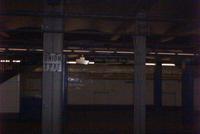 One of the unique features of the Union Turnpike Station (Sorry the pictures are so dark) was its passenger drop off lanes. Union Turnpike divides into a section above ground to intersect with Queens Blvd., while the other runs underground parallel to the Jackie Robinson Parkway. The lanes under Queens Blvd. were designed with pull-off sections allowing cars to pick up and drop off passengers using this station.
One of the unique features of the Union Turnpike Station (Sorry the pictures are so dark) was its passenger drop off lanes. Union Turnpike divides into a section above ground to intersect with Queens Blvd., while the other runs underground parallel to the Jackie Robinson Parkway. The lanes under Queens Blvd. were designed with pull-off sections allowing cars to pick up and drop off passengers using this station.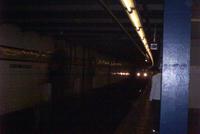 This feature, however, created unresolvable traffic bottlenecks and the lanes were closed about 15 years ago. Today, passengers heading toward the street can still see the cars traveling on the underground section of Union Turnpike, they just can't get into them.
This feature, however, created unresolvable traffic bottlenecks and the lanes were closed about 15 years ago. Today, passengers heading toward the street can still see the cars traveling on the underground section of Union Turnpike, they just can't get into them.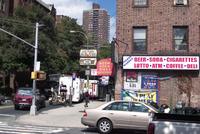
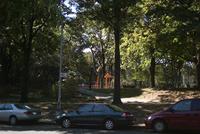
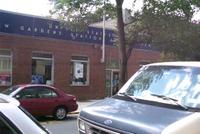 In my opinion, Kew Gardens is one of the prettiest neighborhoods in Queens. In the top picture, the tallest building in the neighborhood, Court Plaza stands over Kew Gardens as if to keep watch over the streets. Below that photo is a view of Forest Park looking across Park Lane South.
In my opinion, Kew Gardens is one of the prettiest neighborhoods in Queens. In the top picture, the tallest building in the neighborhood, Court Plaza stands over Kew Gardens as if to keep watch over the streets. Below that photo is a view of Forest Park looking across Park Lane South.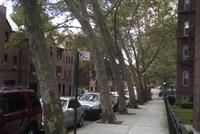
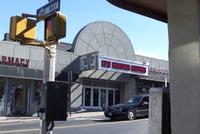
I couldn't resist the opportunity to take a picture of these parallel-leaning sycamore trees on 125th Street. Below that is the Kew Gardens Cinema which features independent, art, and foreign films. For mainstream Hollywood, neighborhood residents must go to neighboring Forest Hills to the Brandon or Midway theaters. Dani's House of Pizza is perhaps the best pizza place in Kew Gardens if you're looking for authentic New York Style, hand-tossed pies. I took this picture from in front of Singa's Famous Pizza, which features a more Middle-Eastern style pizza. Apparently, that's what makes them Famous.
Dani's House of Pizza is perhaps the best pizza place in Kew Gardens if you're looking for authentic New York Style, hand-tossed pies. I took this picture from in front of Singa's Famous Pizza, which features a more Middle-Eastern style pizza. Apparently, that's what makes them Famous.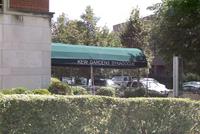 There are four synagogues within four blocks of my apartment (see my previous entry for a definition of a "block.") Our church plant is in Forest Hills which borders Kew Gardens. Our prayer is for our church to win neighboring communities through the faithful preaching of the Gospel. Our reach should go beyond Forest Hills and into neighboring communities.
There are four synagogues within four blocks of my apartment (see my previous entry for a definition of a "block.") Our church plant is in Forest Hills which borders Kew Gardens. Our prayer is for our church to win neighboring communities through the faithful preaching of the Gospel. Our reach should go beyond Forest Hills and into neighboring communities.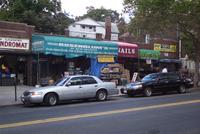
Above is part of Lefferts Blvd. (the street where I live). Notice the Orthodox Jewish store and the Middle Eastern Meat shop in the picture. Several cultures (like most of Queens) are represented in Kew Gardens. (Click on the photos to enlarge)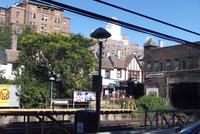
This is a shot of the Kew Gardens Long Island Railroad Station. This is the place where the neighborhood first recognized its current name. This section of Queens had been known only as North Richmond Hill until this station was built in 1909. Upon completion, the destination marker on the station house read simply, "Kew." A local newspaper criticised this name, calling it "Kewte," and saying that it would never catch on. The name was given to the area by local entrepreneur Abraham Wolosoff after the town where England's Royal Botanical Gardens are. It was in recognition of this, and the neighborhood's proximity to nearby Forest Hills Gardens, that the word Gardens was later added to the name.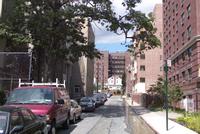
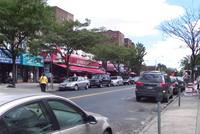
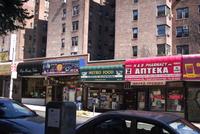 Just a few typical street scenes in Kew Gardens. Note the house in the center of the top photo. Kew Gardens is a neighborhood of contrasts. Amidst large apartment buildings are several older homes reflective of the less-than-urban history of Queens.
Just a few typical street scenes in Kew Gardens. Note the house in the center of the top photo. Kew Gardens is a neighborhood of contrasts. Amidst large apartment buildings are several older homes reflective of the less-than-urban history of Queens.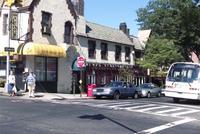
Above is Austin's Ale House on Austin St. just off Lefferts Blvd. Apparently, comedian Rodney Dangerfield was born in the apartment above Austin's.
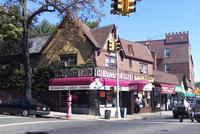 The Village Diner. A great place for healthy portions of fattening food. If you've ever been to a diner, you know what I mean.
The Village Diner. A great place for healthy portions of fattening food. If you've ever been to a diner, you know what I mean.
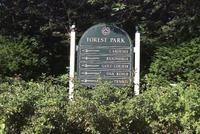 The Eastern Entrance to Forest Park. Aside from a few playgrounds, a carousel, and a golf course, this is (as its name suggests) primarily comprised of thick Oak forest. If the picture was bigger one would notice an arrow pointing to Oak Ridge (yes, Jason, from this vantage point, the arrow does, in fact, point south. Click on the photo to enlarge).
The Eastern Entrance to Forest Park. Aside from a few playgrounds, a carousel, and a golf course, this is (as its name suggests) primarily comprised of thick Oak forest. If the picture was bigger one would notice an arrow pointing to Oak Ridge (yes, Jason, from this vantage point, the arrow does, in fact, point south. Click on the photo to enlarge).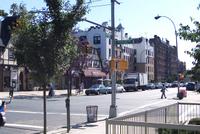 The intersection of Lefferts Blvd. and Metropolitan Ave. (near my apartment). Lefferts Blvd. is named for John Lefferts who sold 200 acres of Queens farmland to Albon Man, developer of North Richmond Hill. He got approximately $57,000 in the deal. Imagine what 200 acres of land in Queens (if there was that much available property) would be worth today. It was similar land acquisitions in Queens and Staten Island over the next 30 years which eventually led lawmakers to draw up the Greater New York Act of 1897, which brought Brooklyn, Queens, and Staten Island under the New York umbrella. Metropolitan Ave. once served as a toll road taking passengers and merchandise between Jamaica, Brooklyn and New York. Metropolitan Ave., obviously, wasn't named after anyone. (*I am hoping to run an entry on this blog in the future on a brief historical snapshot of Queens. Visit here often.)
The intersection of Lefferts Blvd. and Metropolitan Ave. (near my apartment). Lefferts Blvd. is named for John Lefferts who sold 200 acres of Queens farmland to Albon Man, developer of North Richmond Hill. He got approximately $57,000 in the deal. Imagine what 200 acres of land in Queens (if there was that much available property) would be worth today. It was similar land acquisitions in Queens and Staten Island over the next 30 years which eventually led lawmakers to draw up the Greater New York Act of 1897, which brought Brooklyn, Queens, and Staten Island under the New York umbrella. Metropolitan Ave. once served as a toll road taking passengers and merchandise between Jamaica, Brooklyn and New York. Metropolitan Ave., obviously, wasn't named after anyone. (*I am hoping to run an entry on this blog in the future on a brief historical snapshot of Queens. Visit here often.)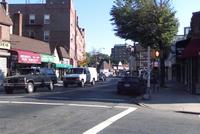
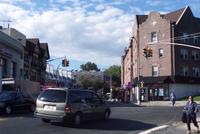
North (top) and South (bottom) views up and down Lefferts Blvd. in the section of Kew Gardens unoficially called "The Village."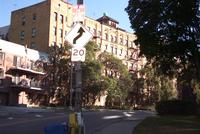 Here is the building I currently call home. It's a great building and a great location. It's a bit different from where I was living in Jackson, MS.
Here is the building I currently call home. It's a great building and a great location. It's a bit different from where I was living in Jackson, MS.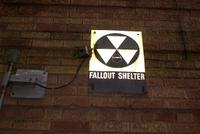
A throw-back to the Cold War. Signs like this one on my building, appear on older buildings accross the five boroughs, faithfully directing us where to go if the Soviets ever push "The Button."
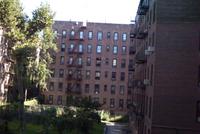 This is the view from my living room window. If anyone tells you that Queens is not very city-like, show them these pictures.
This is the view from my living room window. If anyone tells you that Queens is not very city-like, show them these pictures.
The purpose of this entry is not merely to show you where I live, but to give you a visual sense of the environment in which our church plant will operate. Please keep our church plant in your prayers. It's continuing to develop.
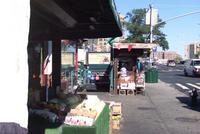
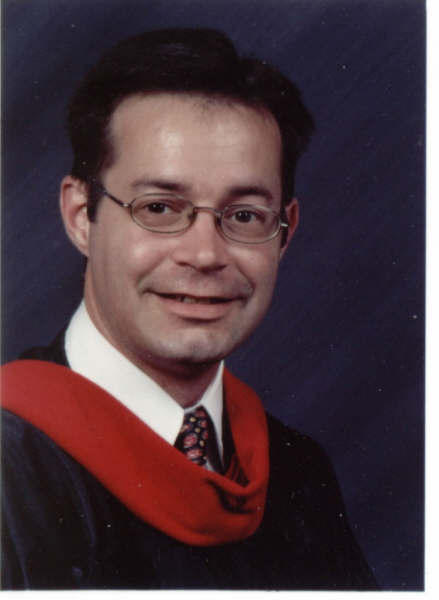

0 Comments:
Post a Comment
<< Home